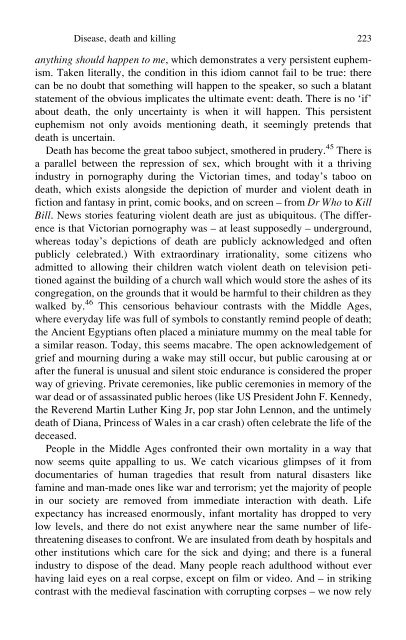Forbidden Words: Taboo and the Censoring of Language
Forbidden Words: Taboo and the Censoring of Language
Forbidden Words: Taboo and the Censoring of Language
You also want an ePaper? Increase the reach of your titles
YUMPU automatically turns print PDFs into web optimized ePapers that Google loves.
Disease, death <strong>and</strong> killing 223<br />
anything should happen to me, which demonstrates a very persistent euphemism.<br />
Taken literally, <strong>the</strong> condition in this idiom cannot fail to be true: <strong>the</strong>re<br />
can be no doubt that something will happen to <strong>the</strong> speaker, so such a blatant<br />
statement <strong>of</strong> <strong>the</strong> obvious implicates <strong>the</strong> ultimate event: death. There is no ‘if’<br />
about death, <strong>the</strong> only uncertainty is when it will happen. This persistent<br />
euphemism not only avoids mentioning death, it seemingly pretends that<br />
death is uncertain.<br />
Death has become <strong>the</strong> great taboo subject, smo<strong>the</strong>red in prudery. 45 There is<br />
a parallel between <strong>the</strong> repression <strong>of</strong> sex, which brought with it a thriving<br />
industry in pornography during <strong>the</strong> Victorian times, <strong>and</strong> today’s taboo on<br />
death, which exists alongside <strong>the</strong> depiction <strong>of</strong> murder <strong>and</strong> violent death in<br />
fiction <strong>and</strong> fantasy in print, comic books, <strong>and</strong> on screen – from Dr Who to Kill<br />
Bill. News stories featuring violent death are just as ubiquitous. (The difference<br />
is that Victorian pornography was – at least supposedly – underground,<br />
whereas today’s depictions <strong>of</strong> death are publicly acknowledged <strong>and</strong> <strong>of</strong>ten<br />
publicly celebrated.) With extraordinary irrationality, some citizens who<br />
admitted to allowing <strong>the</strong>ir children watch violent death on television petitioned<br />
against <strong>the</strong> building <strong>of</strong> a church wall which would store <strong>the</strong> ashes <strong>of</strong> its<br />
congregation, on <strong>the</strong> grounds that it would be harmful to <strong>the</strong>ir children as <strong>the</strong>y<br />
walked by. 46 This censorious behaviour contrasts with <strong>the</strong> Middle Ages,<br />
where everyday life was full <strong>of</strong> symbols to constantly remind people <strong>of</strong> death;<br />
<strong>the</strong> Ancient Egyptians <strong>of</strong>ten placed a miniature mummy on <strong>the</strong> meal table for<br />
a similar reason. Today, this seems macabre. The open acknowledgement <strong>of</strong><br />
grief <strong>and</strong> mourning during a wake may still occur, but public carousing at or<br />
after <strong>the</strong> funeral is unusual <strong>and</strong> silent stoic endurance is considered <strong>the</strong> proper<br />
way <strong>of</strong> grieving. Private ceremonies, like public ceremonies in memory <strong>of</strong> <strong>the</strong><br />
war dead or <strong>of</strong> assassinated public heroes (like US President John F. Kennedy,<br />
<strong>the</strong> Reverend Martin Lu<strong>the</strong>r King Jr, pop star John Lennon, <strong>and</strong> <strong>the</strong> untimely<br />
death <strong>of</strong> Diana, Princess <strong>of</strong> Wales in a car crash) <strong>of</strong>ten celebrate <strong>the</strong> life <strong>of</strong> <strong>the</strong><br />
deceased.<br />
People in <strong>the</strong> Middle Ages confronted <strong>the</strong>ir own mortality in a way that<br />
now seems quite appalling to us. We catch vicarious glimpses <strong>of</strong> it from<br />
documentaries <strong>of</strong> human tragedies that result from natural disasters like<br />
famine <strong>and</strong> man-made ones like war <strong>and</strong> terrorism; yet <strong>the</strong> majority <strong>of</strong> people<br />
in our society are removed from immediate interaction with death. Life<br />
expectancy has increased enormously, infant mortality has dropped to very<br />
low levels, <strong>and</strong> <strong>the</strong>re do not exist anywhere near <strong>the</strong> same number <strong>of</strong> lifethreatening<br />
diseases to confront. We are insulated from death by hospitals <strong>and</strong><br />
o<strong>the</strong>r institutions which care for <strong>the</strong> sick <strong>and</strong> dying; <strong>and</strong> <strong>the</strong>re is a funeral<br />
industry to dispose <strong>of</strong> <strong>the</strong> dead. Many people reach adulthood without ever<br />
having laid eyes on a real corpse, except on film or video. And – in striking<br />
contrast with <strong>the</strong> medieval fascination with corrupting corpses – we now rely

















